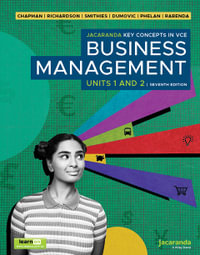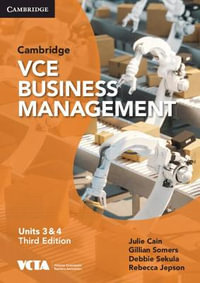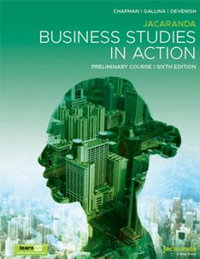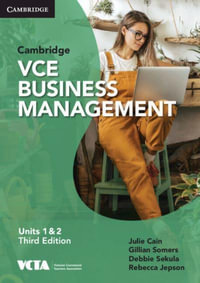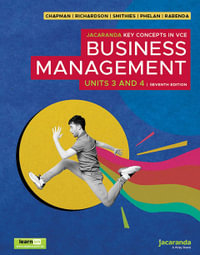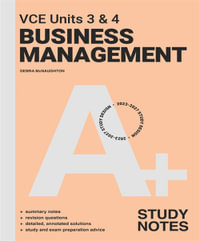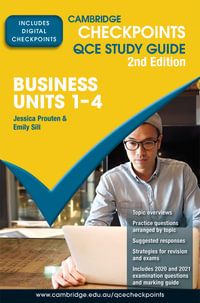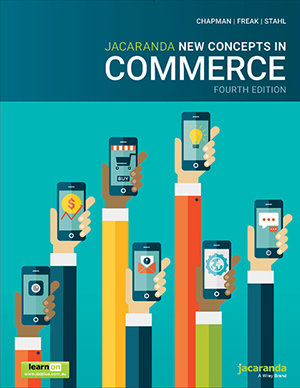
Jacaranda New Concepts in Commerce
New South Wales Australian curriculum 4E learnON & print
Paperback | 29 January 2020 | Edition Number 4
At a Glance
672 Pages
Revised
28 x 22 x 2.5
Paperback
RRP $90.00
$88.25
or 4 interest-free payments of $22.06 with
orWhen will this arrive by?
This combined print and digital title provides 100% coverage of the NSW Ac Commerce Syllabus (June 2019). The textbook comes with a complimentary activation code for learnON, the powerful digital learning platform making learning personalised and visible for both students and teachers.
The latest edition of Jacaranda New Concepts in Commerce include these key features:
- A fully revised fourth edition comprehensively covers the four core and seven option topics from the NSW Ac Commerce 7-10 Syllabus (June 2019), due to be implemented in Term 1 2020.
- All student worksheets are now included free in the student edition - no separate workbook purchase necessary!
- A rich bank of teacher support material including detailed Syllabus and teacher notes, additional activities, teacher an learning programs, and much more
- Now available on learnON, an immersive new eBook where everything is in one place for a dynamic and uninterrupted learning experience
- Teacher your class, your way, with trusted content, delivered consistently across all formats including learnON, eBookPLUS, iPad app, print and PDF
Syllabus table ix
How to use the Jacaranda New Concepts in Commerce resource suite xii
Acknowledgements xv
Core Study Topics 1
1 Consumer and financial decisions 3
1.1 Overview 3
1.2 The nature of commerce 4
1.3 Key factors affecting consumer and financial decisions 6
1.4 How individuals make particular decisions 9
1.5 Choosing where to buy 12
1.6 Different payment options 20
1.7 SkillBuilder: Comparison shopping investigation 27
1.8 Consumer protection 28
1.9 Reasons for and features of a simple contract 31
1.10 Legal rights and responsibilities of consumers 34
1.11 Organisations that provide assistance for consumers 37
1.12 SkillBuilder: Questioning and research 40
1.13 Processes of consumer redress 41
1.14 Financial management 43
1.15 Importance of long-term financial strategies 46
1.16 Tools and strategies for effective financial management 49
1.17 Options for addressing financial difficulty 55
1.18 Impact of technology on consumer decisions 58
1.19 Thinking Big research project: Smart financial management 60
1.20 Review 61
2 The economic and business environment 68
2.1 Overview 68
2.2 The five-sector circular flow model 69
2.3 The interdependence between different sectors of the economy 72
2.4 The business cycle 74
2.5 The price mechanism and the interaction of demand and supply within a market 79
2.6 SkillBuilder: Communicating information in tables and graphs 85
2.7 What is a market? 87
2.8 SkillBuilder: Contesting and debating ideas 90
2.9 Customary trading practices of Aboriginal Peoples and Torres Strait Islander Peoples 93
2.10 The reasons for government intervention in the market 95
2.11 Different types of businesses 97
2.12 Factors influencing business decisions 101
2.13 The contribution of entrepreneurship and innovation 103
2.14 Ethical decision-making and corporate social responsibility 105
2.15 Thinking Big research project: Please stop calling 107
2.16 Review 108
3 Employment and work futures 112
3.1 Overview 112
3.2 Work and wellbeing 113
3.3 Workplace participants 118
3.4 Types of employment and work arrangements 125
3.5 The nature of work 131
3.6 Patterns of employment 134
3.7 SkillBuilder: Analysis and interpretation of data 143
3.8 Rights and responsibilities in the workplace 145
3.9 Responsibilities to workers and the government 152
3.10 Laws relating to the workplace 158
3.11 Anti-discrimination and unfair dismissal 160
3.12 Resolving disputes 163
3.13 Current issues within the scope of employment 166
3.14 SkillBuilder: Analysis and interpretation of graphs 170
3.15 Employment opportunities 174
3.16 Different pathways in education and training 176
3.17 SkillBuilder: Preparing a resume 179
3.18 Work in the future 182
3.19 Thinking Big research project: Workplace evolution presentation 187
3.20 Review 188
4 Law, society and political involvement 193
4.1 Overview 193
4.2 Reasons for laws 194
4.3 Values, morals and ethics 196
4.4 Australia’s court system 198
4.5 The role of court personnel 203
4.6 The role and selection of juries 205
4.7 How laws are made: common law 207
4.8 How laws are made: statute law 210
4.9 How a bill becomes a law 213
4.10 Types of law 215
4.11 Civil law 217
4.12 Criminal law 220
4.13 Customary law 223
4.14 Domestic versus international law 225
4.15 Accessing the law 227
4.16 SkillBuilder: Debating an issue 229
4.17 The three levels of government 232
4.18 Why do laws change? 235
4.19 Political action 237
4.20 Referendums 240
4.21 Participating in the democratic process 243
4.22 Voting in the democratic process 247
4.23 Rights and responsibilities in the democratic process 249
4.24 Role and function of political parties 252
4.25 The inner workings of Australia’s government 254
4.26 Separation of powers 258
4.27 SkillBuilder: Problem solving and decision making 26 2
4.28 Thinking Big research project: Making laws 264
4.29 Review 265
Option Topics 273
5 Our economy 275
5.1 Overview 275
5.2 Ways of assessing the performance of the Australian economy 276
5.3 Government macroeconomic policy tools (monetary policy/fiscal policy) 286
5.4 Government microeconomic policy tools (trade, education, productivity) 293
5.5 Economic growth rates 298
5.6 Unemployment trends 304
5.7 Inflation rates and sustainability indexes 310
5.8 SkillBuilder: Calculating inflation 314
5.9 Sustainability indexes 315
5.10 SkillBuilder: Sustainable Development Goals 321
5.11 International trade and the Australian economy 325
5.12 The interdependence of Australia with other global economies 334
5.13 The impact of government on Australia’s international trade 337
5.14 Global influences on the Australian economy and the interactions between the international and domestic business cycles 340
5.15 Thinking Big research project: How does Australia measure up? 350
5.16 Review 352
6 Investing 358
6.1 Overview 358
6.2 Reasons for investing 359
6.3 Financing your investment 361
6.4 Range of investment options 365
6.5 SkillBuilder: Reading a sharemarket chart 368
6.6 Ethical investments 371
6.7 The relationship between risk and return 373
6.8 Factors influencing an investment portfolio 376
6.9 Investment planning – maintaining records and monitoring investments 380
6.10 Managing investments and risk mitigation 383
6.11 The role and responsibilities of the financial services industry 386
6.12 Thinking Big research project: It’s a risky business 391
6.13 Review 393
7 Promoting and selling 397
7.1 Overview 397
7.2 The selling process 398
7.3 Nature of product promotion 403
7.4 Targeting customers 411
7.5 Legal and ethical issues arising from particular product promotion 415
7.6 Selling techniques 420
7.7 The effectiveness of selling techniques used for a particular product or service 424
7.8 Factors influencing contemporary selling techniques 427
7.9 SkillBuilder: Questioning and research 432
7.10 Thinking Big research project: Hitting the target — multimedia advertising campaign 433
7.11 Review 435
8 Running a business 439
8.1 Overview 439
8.2 Being an entrepreneur 440
8.3 SkillBuilder: Cost–benefit analysis 447
8.4 Planning for success 451
8.5 Key features of organisational structures 454
8.6 Establishing a new business or purchasing an existing business 460
8.7 Business operations 468
8.8 Maintaining financial records 477
8.9 Thinking Big research project: Pitch a business idea 486
8.10 Review 488
9 Law in action 492
9.1 Overview 492
9.2 Contact with the law 493
9.3 Contact with the criminal law and elements of crime 496
9.4 Punishment for a crime 499
9.5 Contact with civil law 502
9.6 The impact of civil and criminal law on young people 505
9.7 Rights and responsibilities of individuals 507
9.8 The role of law enforcement agencies 510
9.9 Dispute resolution outside of the courts 513
9.10 Dispute resolution in Aboriginal and Torres Strait Islander communities 516
9.11 Dispute resolution by the United Nations 519
9.12 Rights and freedoms in the Democratic People’s Republic of Korea 522
9.13 SkillBuilder: Group consensus 525
9.14 Thinking Big research project: Create a bill of rights 527
9.15 Review 529
10 Travel 534
10.1 Overview 534
10.2 The nature of tourism 535
10.3 Planning a trip 541
10.4 Advantages and disadvantages of various means of travel 548
10.5 Travel planning options 552
10.6 Considerations when planning a trip 554
10.7 Organising a passport and visa 559
10.8 Developing an itinerary 562
10.9 Solving problems related to travel 569
10.10 Current issues and impacts of travel 572
10.11 Thinking Big research project: Design a 7-day cruise adventure 575
10.12 Review 577
11 Towards independence 582
11.1 Overview 582
11.2 Moving from home 583
11.3 Arranging accommodation 587
11.4 Accessing information available relating to arranging a lease 590
11.5 Managing finances 596
11.6 Managing finances – insurance options 601
11.7 Major purchases 604
11.8 Options available for the purchase of major items 608
11.9 SkillBuilder: Choosing a mobile phone plan 613
11.10 Community involvement 615
11.11 SkillBuilder: Communication and reflection 620
11.12 SkillBuilder: Delivering an oral presentation 621
11.13 Current issues 623
11.14 Thinking Big research project: Designing a website 625
11.15 Review 626
Glossary 631
Index 641
ISBN: 9780730358152
ISBN-10: 0730358151
Series: New Concepts in Commerce series
Published: 29th January 2020
Format: Paperback
Language: English
Number of Pages: 672
Audience: Primary, Secondary and High School
Publisher: John Wiley & Sons Australia
Country of Publication: AU
Edition Number: 4
Edition Type: Revised
Dimensions (cm): 28 x 22 x 2.5
Weight (kg): 1.35
Shipping
| Standard Shipping | Express Shipping | |
|---|---|---|
| Metro postcodes: | $9.99 | $14.95 |
| Regional postcodes: | $9.99 | $14.95 |
| Rural postcodes: | $9.99 | $14.95 |
How to return your order
At Booktopia, we offer hassle-free returns in accordance with our returns policy. If you wish to return an item, please get in touch with Booktopia Customer Care.
Additional postage charges may be applicable.
Defective items
If there is a problem with any of the items received for your order then the Booktopia Customer Care team is ready to assist you.
For more info please visit our Help Centre.






